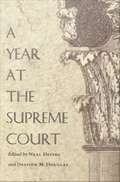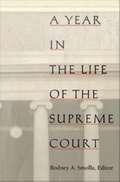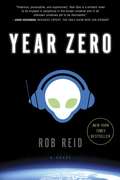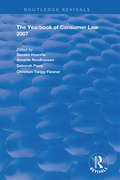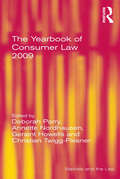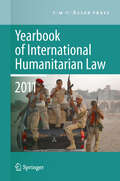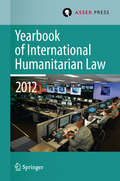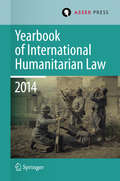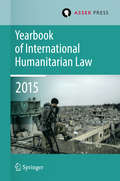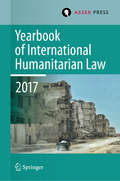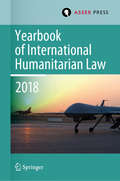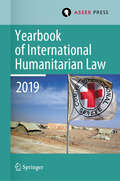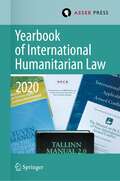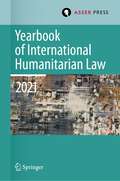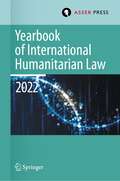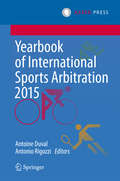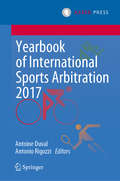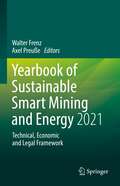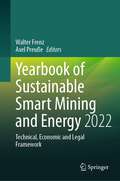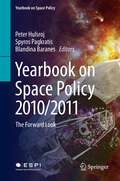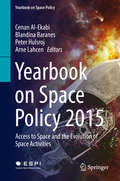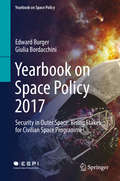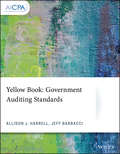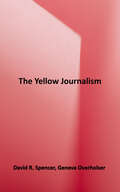- Table View
- List View
A Year at the Supreme Court
by Neal Devins Davison M. DouglasThe United States Supreme Court's 2002-03 term confounded Court watchers. The same Rehnquist Court that many had seen as solidly conservative and unduly activist--the Court that helped decide the 2000 presidential election and struck down thirty-one federal statutes since 1995--issued a set of surprising, watershed rulings. In a term filled with important and unpredictable decisions, it upheld affirmative action, invalidated a same-sex sodomy statute, and reversed a death sentence due to ineffective assistance of counsel. With essays focused on individual Justices, Court practices, and some of last year's most important rulings, this volume explores the meaning and significance of the Court's 2002-03 term. Seasoned Supreme Court advocates and journalists from The New Republic, The Los Angeles Times, Newsweek, National Journal, Slate, and Legal Times grapple with questions about the Rehnquist Court's identity and the Supreme Court's role in the political life of the country. Some essays consider the role of "swing" Justices Sandra Day O'Connor and Anthony Kennedy within a Court that divides 5-4 more than any other group of Justices in the nation's history. Others examine the political reaction to and legal context of the Court's Lawrence v. Texas decision declaring a Texas law criminalizing homosexual sodomy unconstitutional. Contributors analyze the Court's rulings on affirmative action and reassess its commitment to states' rights. Considering the Court's practices, one advocate explores the use and utility of amicus curiae, or "friend of the court" briefs, while another reflects on indications of an increased openness by the Court to public scrutiny. Two advocates who argued cases before the Court--one related to hate speech and the other to a "three strikes and you're out" criminal statute--offer vivid accounts of their experiences. Intended for general readers, A Year at the Supreme Court is for all those who want to understand the Rehnquist Court and its momentous 2002-03 term. Contributors Erwin Chemerinsky Neal Devins Davison M. Douglas David J. Garrow Dahlia Lithwick Tony Mauro Carter Phillips Ramesh Ponnuru Jeffrey Rosen David G. Savage Rodney A. Smolla Stuart Taylor Jr.
A Year in the Life of the Supreme Court
by Paul Barrett Richard Carelli Marcia Coyle Lyle Denniston Aaron Epstein Kay Kindred Tony Mauro David Savage Stephen WermielDespite its importance to the life of the nation and all its citizens, the Supreme Court remains a mystery to most Americans, its workings widely felt but rarely seen firsthand. In this book, journalists who cover the Court--acting as the eyes and ears of not just the American people, but the Constitution itself--give us a rare close look into its proceedings, the people behind them, and the complex, often fascinating ways in which justice is ultimately served. Their narratives form an intimate account of a year in the life of the Supreme Court. The cases heard by the Surpreme Court are, first and foremost, disputes involving real people with actual stories. The accidents and twists of circumstance that have brought these people to the last resort of litigation can make for compelling drama. The contributors to this volume bring these dramatic stories to life, using them as a backdrop for the larger issues of law and social policy that constitute the Court's business: abortion, separation of church and state, freedom of speech, the right of privacy, crime, violence, discrimination, and the death penalty. In the course of these narratives, the authors describe the personalities and jurisprudential leanings of the various Justices, explaining how the interplay of these characters and theories about the Constitution interact to influence the Court's decisions. Highly readable and richly informative, this book offers an unusually clear and comprehensive portrait of one of the most influential institutions in modern American life.
Year Zero: A Novel
by Rob ReidAn alien advance party was suddenly nosing around my planet. Worse, they were lawyering up. . . . In the hilarious tradition of The Hitchhiker's Guide to the Galaxy, Rob Reid takes you on a headlong journey through the outer reaches of the universe--and the inner workings of our absurdly dysfunctional music industry. Low-level entertainment lawyer Nick Carter thinks it's a prank, not an alien encounter, when a redheaded mullah and a curvaceous nun show up at his office. But Frampton and Carly are highly advanced (if bumbling) extraterrestrials. And boy, do they have news. The entire cosmos, they tell him, has been hopelessly hooked on humanity's music ever since "Year Zero" (1977 to us), when American pop songs first reached alien ears. This addiction has driven a vast intergalactic society to commit the biggest copyright violation since the Big Bang. The resulting fines and penalties have bankrupted the whole universe. We humans suddenly own everything--and the aliens are not amused. Nick Carter has just been tapped to clean up this mess before things get ugly, and he's an unlikely galaxy-hopping hero: He's scared of heights. He's also about to be fired. And he happens to have the same name as a Backstreet Boy. But he does know a thing or two about copyright law. And he's packing a couple of other pencil-pushing superpowers that could come in handy. Soon he's on the run from a sinister parrot and a highly combustible vacuum cleaner. With Carly and Frampton as his guides, Nick now has forty-eight hours to save humanity, while hopefully wowing the hot girl who lives down the hall from him."Hilarious, provocative, and supersmart, Year Zero is a brilliant novel to be enjoyed in perpetuity in the known universe and in all unknown universes yet to be discovered."--John Hodgman, resident expert, The Daily Show with Jon StewartFrom the Hardcover edition.
The Yearbook of Consumer Law 2007 (Routledge Revivals)
by Geraint Howells Annette Nordhausen Deborah Parry Christian Twigg-FlesnerFirst published in 2007, The Yearbook of Consumer Law provides a valuable guide to developments in the consumer law field with a domestic, regional and international dimension. The volume presents a range of peer-reviewed scholarly articles, analytical in approach and focusing on specific areas of consumer law such as sales, credit and safety, as well as more general issues, such as consumer law theory. The book also includes a section dedicated to significant developments during the period covered, such as key legislative developments or important court decisions. The book provides an essential resource for all those, academic and practitioner, working in the areas of consumer law and policy.
The Yearbook of Consumer Law 2009 (Markets and the Law)
by Geraint Howells Annette NordhausenThe Yearbook of Consumer Law provides a valuable outlet for high quality scholarly work which tracks developments in the consumer law field with a domestic, regional and international dimension. The 2009 volume presents a range of peer-reviewed scholarly articles, analytical in approach and focusing on specific areas of consumer law such as credit, consumer redress and the impact of the European Union on consumer law. The book also includes a section dedicated to significant developments during the period covered, such as key legislative developments and important court decisions. It is an essential resource for all academics and practitioners working in the areas of consumer law and policy.
Yearbook of International Humanitarian Law 2011 - Volume 14
by Michael N. Schmitt Louise ArimatsuThe Yearbook of International Humanitarian Law is the world's only annual publication devoted to the study of the laws governing armed conflict. It provides a truly international forum for high-quality, peer-reviewed academic articles focusing on this crucial branch of international law. Distinguished by contemporary relevance, the Yearbook of International Humanitarian Law bridges the gap between theory and practice and serves as a useful reference tool for scholars, practitioners, military personnel, civil servants, diplomats, human rights workers and students.
Yearbook of International Humanitarian Law Volume 15, 2012
by Terry D. Gill Robin Geiß Robert Heinsch Tim Mccormack Christophe Paulussen Jessica Dorsey'Child Soldiers and the Lubanga Case' and 'The Tallinn Manual on the International Law Applicable to Cyber Warfare' are the two central themes of this volume. Each of these timely topics is addressed from three different angles, providing a truly comprehensive analysis of the subject. The book also features an article on the duty to investigate civilian casualties during armed conflict and its implementation in practice and an elaborate year in review, discussing developments that occurred in 2012. The Yearbook of International Humanitarian Law is the world's only annual publication devoted to the study of the laws governing armed conflict. It provides a truly international forum for high-quality, peer-reviewed academic articles focusing on this crucial branch of international law. Distinguished by contemporary relevance, the Yearbook of International Humanitarian Law bridges the gap between theory and practice and serves as a useful reference tool for scholars, practitioners, military personnel, civil servants, diplomats, human rights workers and students.
Yearbook of International Humanitarian Law Volume 17, 2014
by Terry D. Gill Robin Geiß Heike Krieger Tim Mccormack Christophe Paulussen Jessica DorseyThis volume commemorates the centenary of the FirstWorld War (1914-2014) and aims to capture 100 years of warfare evolution. Amongthe main issues addressed are the changing nature of means and methods ofwarfare, the law of weaponry, and challenges to humanitarian assistance andprotection of the civilian population affected by armed conflict. Specifictopics include the legal regime governing nuclear weapons, the prohibition ofchemical weapons and arms control, the evolution of naval warfare, asymmetricconflicts, the law of occupation and cultural property. A comprehensive Year in Review also describes themost important events and legal developments that took place in 2014. The Yearbook ofInternational Humanitarian Law is the world's only annual publicationdevoted to the study of the laws governing armed conflict. It provides a trulyinternational forum for high-quality, peer-reviewed academic articles focusingon this crucial branch of international law. Distinguished by contemporaryrelevance, the Yearbook of InternationalHumanitarian Law bridges the gap between theory and practice and serves asa useful reference tool for scholars, practitioners, military personnel, civilservants, diplomats, human rights workers and students.
Yearbook of International Humanitarian Law Volume 18, 2015 (Yearbook of International Humanitarian Law #18)
by Terry D. GillThe general theme of this volume is contemporary armed conflicts and their implications for international humanitarian law. It is elaborated upon in several chapters, dealing with a variety of topics related to, among other things, the situations in Libya, Transnistria, Mexico, Syria/Iraq (Islamic State) and Israel/Gaza. Besides these chapters that can be connected to the general theme, this volume also contains a chapter dedicated to an international criminal law topic (duress), as well as a Year in Review, describing the most important events and legal developments that took place in 2015. The Yearbook of International Humanitarian Law is the world’s only annual publication devoted to the study of the laws governing armed conflict. It provides a truly international forum for high-quality, peer-reviewed academic articles focusing on this crucial branch of international law. Distinguished by contemporary relevance, the Yearbook of International Humanitarian Law bridges the gap between theory and practice and serves as a useful reference tool for scholars, practitioners, military personnel, civil servants, diplomats, human rights workers and students.
Yearbook of International Humanitarian Law, Volume 20, 2017 (Yearbook of International Humanitarian Law #20)
by Terry D. Gill Tim McCormack Robin Geiß Heike Krieger Christophe PaulussenThe main theme of this volume of the Yearbook of International Humanitarian Lawis the development and interpretation of international humanitarian law (IHL). It iselaborated upon in several chapters that examine the role of non-state armed groupsin the development and interpretation of IHL, the impact of international criminal lawon the development of IHL, the notion of external non-international armed conflicts,and the regulation of prolonged occupation under international law.The second theme of this volume is dedicated to targeting in armed conflicts. Specifictopics include precautions in attack in urban and siege warfare, the targeting of theIslamic State’s religious personnel in Iraq and Syria, and the targeting of illicit cropsthrough aerial spraying in Colombia. Besides the chapters that address both themes,this volume also contains a Year in Review describing the most important events andlegal developments that took place in 2017.The Yearbook of International Humanitarian Law is the world’s only annual publicationdevoted to the study of the laws governing armed conflict. It provides a truly internationalforum for high-quality, peer-reviewed academic articles focusing on this crucialbranch of international law. Distinguished by contemporary relevance, the Yearbookof International Humanitarian Law bridges the gap between theory and practice andserves as a useful reference tool for scholars, practitioners, military personnel, civilservants, diplomats, human rights workers and students.
Yearbook of International Humanitarian Law, Volume 21 (Yearbook of International Humanitarian Law #21)
by Terry D. Gill Robin Geiß Heike Krieger Christophe PaulussenThe main theme of this volume of the Yearbook of International Humanitarian Law is weapons law. In several chapters, how International Humanitarian Law (IHL) copes with old and new weapons as well as political developments in regard to military technology is discussed, while in two chapters the significance of non- or less-lethal weapons in peace-keeping and law enforcement operations as well as the legality of lethal autonomous weapon systems under IHL are analysed. Moreover, the volume describes the current status of nuclear deterrence under international law. Another layer is added by examining how IHL influences the programming of automatic target recognition systems using artificial intelligence.The second part of the book contains a historic perspective on the roots of IHL in Europe, which can be traced back to the ninth century, as well as a Year in Review describing the most important events and legal developments in the area of IHL that took place in 2018.The Yearbook of International Humanitarian Law is the world’s only annual publication devoted to the study of the laws governing armed conflict. It provides a truly international forum for high-quality, peer-reviewed academic articles focusing on this crucial branch of international law. Distinguished by contemporary relevance, the Yearbook of International Humanitarian Law bridges the gap between theory and practice and serves as a useful reference tool for scholars, practitioners, military personnel, civil servants, diplomats, human rights workers and students.
Yearbook of International Humanitarian Law, Volume 22 (Yearbook of International Humanitarian Law #22)
by Terry D. Gill Robin Geiß Heike Krieger Christophe PaulussenThe main theme of this volume of the Yearbook of International Humanitarian Law is the 70th anniversary of the Geneva Conventions. The evolution of these crucial treaties and international humanitarian law more generally comes back in six chapters addressing topics such as sieges, compliance, indiscriminate attacks and non-state armed groups.The second part of the book contains a chapter on the acquittal on appeal of Jean-Pierre Bemba Gombo by the International Criminal Court on the basis of command responsibility for war crimes, as well as an extensive Year in Review describing the most important events and legal developments in the area of international humanitarian law that took place in 2019.The Yearbook of International Humanitarian Law is the world’s only annual publication devoted to the study of the laws governing armed conflict. It provides a truly international forum for high-quality, peer-reviewed academic articles focusing on this crucial branch of international law. Distinguished by contemporary relevance, the Yearbook of International Humanitarian Law bridges the gap between theory and practice and serves as a useful reference tool for scholars, practitioners, military personnel, civil servants, diplomats, human rights workers and students.
Yearbook of International Humanitarian Law, Volume 23 (Yearbook of International Humanitarian Law #23)
by Terry D. Gill Robin Geiß Heike Krieger Rebecca Mignot-MahdaviThis volume of the Yearbook of International Humanitarian Law takes a close look at the role of so-called “expert manuals” in the interpretation and development of the international law of armed conflict and connected branches of international law relating to military operations. While these manuals can and do play an undoubtedly useful role, their proliferation raises a number of questions. What degree of authority do they have and how much weight should be given to the views expressed in them? What is the methodology they employ and how effective is it in ensuring an as objective and impartial interpretation of the law as possible? What is their place in the doctrine of sources? While there is already a considerable body of literature addressing these and other relevant questions, this volume aims to contribute further to this discussion with contributions by three experts involved in one or more of these manuals in one capacity or another. Alongside these three contributions on this year’s special theme, the second part of the book comprises three chapters that address timely and relevant issues of International Humanitarian Law. These range from starvation as a method of warfare, to emerging technologies of warfare, and also includes reflections on humanitarian assistance. Lastly, the volume concludes with the Year in Review, describing the most important armed conflict-related events and legal developments that took place in 2020. The Yearbook of International Humanitarian Law is a leading annual publication devoted to the study of international humanitarian law. It provides a truly international forum for high-quality, peer-reviewed academic articles focusing on this crucial branch of international law. Distinguished by contemporary relevance, the Yearbook of International Humanitarian Law bridges the gap between theory and practice and serves as a useful reference tool for scholars, practitioners, military personnel, civil servants, diplomats, human rights workers and students.
Yearbook of International Humanitarian Law, Volume 24: Cultures of International Humanitarian Law (Yearbook of International Humanitarian Law)
by Heike Krieger Eliav Lieblich Rebecca Mignot-Mahdavi Pablo KalmanovitzVolume 24 of the Yearbook of International Humanitarian Law (IHL) is dedicated to investigating IHL’s universalist claims from different perspectives and regarding different areas of IHL. While academic debates about “universalism versus particularism” have dominated much of the critical scholarship in international law over the past two decades, they remain relatively underexplored in the field of IHL. The current volume fills this gap in IHL literature by focusing on the ways in which different interpretive communities approach questions of IHL from differing perspectives. Authors were invited to use the concept of culture to deconstruct and take critical distance from the production, interpretation, and application of IHL, and those keen on challenging the idea that IHL needs critical deconstruction were also invited to argue their case. The Volume contains four articles dedicated to the subject of cultures of IHL. It also features a book symposium on Samuel Moyn’s Humane: How The United States Abandoned Peace and Reinvented War (2021) and ends, as usual, with a Year in Review section. The Yearbook of International Humanitarian Law is a leading annual publication devoted to the study of international humanitarian law. The Yearbook has always strived to be at the forefront of the debate of pressing doctrinal questions of IHL and will continue to do so in the future. As this volume shows, it is also a forum for taking a step back and reflecting on the broader, theoretical issues that inform the practice and thinking about the field. The Yearbook provides an international forum for high-quality, peer-reviewed academic articles focusing on this crucial branch of international law. Distinguished by contemporary relevance, it bridges the gap between theory and practice and serves as a useful reference tool for scholars, practitioners, military personnel, civil servants, diplomats, human rights workers and students.
Yearbook of International Humanitarian Law, Volume 25: International Humanitarian Law and Neighbouring Frameworks (Yearbook of International Humanitarian Law #25)
by Heike Krieger Pablo Kalmanovitz Eliav Lieblich Stavros Evdokimos PantazopoulosVolume 25 of the Yearbook of International Humanitarian Law (IHL) sheds light on the interplay between IHL and other adjacent branches of international law. This Volume moves beyond the traditional preoccupation of examining IHL’s relations with international human rights law, the law on the use of force and international criminal law. Authors were invited to discuss, both in general and specific terms, doctrinally and theoretically, interactions between IHL and other neighbouring frameworks. Accordingly, this Volume is dedicated to exploring the interrelationship between IHL and other adjacent frameworks, such as international environmental law, international investment law, the law on defences to state responsibility, and counter-terrorism law.The Volume contains four articles dedicated to the subject of IHL and neighbouring frameworks. The Volume further features a Focus section on IHL controversies arising from Russia’s aggression against Ukraine, and ends, as usual, with a Year in Review section.The Yearbook of International Humanitarian Law is a leading annual publication devoted to the study of international humanitarian law. The Yearbook has always strived to be at the forefront of the debate of pressing doctrinal questions of IHL, and will continue to do so in the future. As this Volume demonstrates, it offers a space where IHL-related issues can be explored both from a doctrinal and a theoretical perspective. It provides an international forum for high-quality, peer-reviewed academic articles focusing on this crucial branch of international law.Distinguished by contemporary relevance, the Yearbook of International Humanitarian Law bridges the gap between theory and practice and serves as a useful reference tool for scholars, practitioners, military personnel, civil servants, diplomats, human rights workers, and students.
Yearbook of International Sports Arbitration 2015
by Antoine Duval Antonio RigozziThe Yearbook of International Sports Arbitration is the first academic publication aiming to offer comprehensive coverage, on a yearly basis, of the most recent and salient developments regarding international sports arbitration, through a combination of general articles and case notes. The present volume covers decisions rendered by the Court of Arbitration for Sport (CAS) and national courts in 2015. It is a must-have for sports lawyers and arbitrators, as well as researchers engaged in this field. It provides in-depth articles on burning issues raised by international sports arbitration, and independent commentaries by esteemed academics and seasoned practitioners on the most important decisions of the CAS (e. g. the Dutee Chand case) and national courts (e. g. the Pechstein and Wilhelmshaven decision rendered by the OLG M#65533;nchen and OLG Bremen in Germany). Dr. Antoine Duval is Senior Researcher for International and European Sports Law at the T. M. C. Asser Instituut in The Hague. He holds a Ph. D. on the interaction between Lex Sportiva and EU Law from the European University Institute in Florence. Prof. Antonio Rigozzi teaches international arbitration and sports law at the University of Neuch#65533;tel, Switzerland, and is the partner in charge of the sports arbitration practice at L#65533;vy Kaufmann-Kohler, a Geneva-based law firm specializing in international arbitration.
Yearbook of International Sports Arbitration 2017 (Yearbook of International Sports Arbitration)
by Antoine Duval Antonio RigozziThe Yearbook of International Sports Arbitration is the first academic publication aiming to offer comprehensive coverage, on a yearly basis, of the most recent and salient developments regarding international sports arbitration, through a combination of general articles and case notes. The present volume covers decisions rendered by the Court of Arbitration for Sport (CAS) and national courts in 2017. It is a must have for sports lawyers and arbitrators, as well as researchers engaged in this field. It provides in-depth articles on current issues raised by international sports arbitration, and commentaries by esteemed academics and experienced practitioners on the most important decisions of the year by the CAS and national courts.Dr. Antoine Duval is Senior Researcher at the T.M.C. Asser Instituut in The Hague and heads the Asser International Sports Law Centre. Prof. Antonio Rigozzi teaches international arbitration and sports law at the University of Neuchâtel, Switzerland, and is the partner in charge of the sports arbitration practice at Lévy Kaufmann-Kohler, a Geneva-based law firm specializing in international arbitration.
Yearbook of International Sports Arbitration 2018–2020 (Yearbook of International Sports Arbitration)
by Antoine Duval Antonio RigozziThe Yearbook of International Sports Arbitration is the first academic publication aiming to offer comprehensive coverage, on a yearly basis, of the most recent and salient developments regarding international sports arbitration, through a combination of general articles and case notes. The present volume covers decisions rendered by the Court of Arbitration for Sport (CAS), and national courts significant international and domestic between 2018-2020. It is a must-have for sports lawyers, arbitrators, and researchers engaged in this field. From the ECtHR's landmark ruling in the Mutu & Pechstein case, through the Russian doping scandal, to the first Sun Yang award, it features in-depth articles on important issues raised by international sports arbitration, as well as independent commentaries by academics and practitioners on the most significant international and domestic decisions rendered in the period under review. Dr. Antoine Duval is Senior Researcher at the T.M.C. Asser Instituut in The Hague and heads the Asser International Sports Law Centre. Prof. Antonio Rigozzi teaches international arbitration and sports law at the University of Neuchâtel, Switzerland, and is the partner in charge of the sports arbitration practice at Lévy Kaufmann-Kohler, a Geneva-based law firm specializing in international arbitration.
Yearbook of Sustainable Smart Mining and Energy 2021: Technical, Economic and Legal Framework (Yearbook of Sustainable Smart Mining and Energy - Technical, Economic and Legal Framework #1)
by Walter Frenz Axel PreußeThis book is at the center of the UN goals of combining environment and economic development with new technologies.First, sustainability in mining is defined as a process of transformation. This is followed by an outlook on the aspects of safety, economy, environmental impact and digital transformation. The book includes a discussion of new aspects such as the problem of liability for mining damages regarding climate change in Peru. Specific technical issues in smart mining are covered as well, such as underground localization systems based on ultra-wide band radio and inertial navigation, or the use of thermal imaging for roof crack detection. In addition, the characterization of material flows, subsurface hydrogen-storage systems and the prediction of mining induced subsidence and uplift are dealt with.The Sustainable Smart Mining and Energy Yearbook is not only aimed at researchers professionals, but at all who want to get an overview of the important technical and legal topics in this field.
Yearbook of Sustainable Smart Mining and Energy 2022: Technical, Economic and Legal Framework (Yearbook of Sustainable Smart Mining and Energy - Technical, Economic and Legal Framework #2)
by Walter Frenz Axel PreußeThis book covers several aspects of the application of Sustainable Development Goals to mining related subjects. The included works range from methods to assess and implement sustainability to discussions of legal impacts and relations as well as technological developments and outlooks. First, the challenges and opportunities of clean energy transition in the African mining sector are described. With regard to the assessment of sustainable developments, this book includes the applications of the sieving method, the concept of thermodynamics and the United Nations Framework Classification to mining projects and case studies. The implementation of Sustainable Development Goals into academic project work and education of geo-engineers is covered as well. The legal topics contain discussions of corporate climate liabilities and extraterritorial legal responsibilities as well as an analysis of the impact of the German Federal Constitutional Court's climate decision. Important mining aspects and technological developments like proactive water management, sustainable approaches to mine closure and implementation of ventilation on demand in underground mines are described. In addition, the state and potential of the Mongolian raw materials industry is covered. The Sustainable Smart Mining and Energy Yearbook is not only aimed at researchers and professionals, but at all who want to get an overview of current important technical and legal topics in this field.
Yearbook on Space Policy 2010/2011
by Peter Hulsroj Blandina Baranes Spyros PagkratisThe Yearbook on Space Policy is the reference publication analysing space policy developments. Each year it presents issues and trends in space policy and the space sector as a whole. Its scope is global and its perspective is European. The Yearbook also links space policy with other policy areas. It highlights specific events and issues, and provides useful insights, data and information on space activities. The Yearbook on Space Policy is edited by the European Space Policy Institute (ESPI) based in Vienna, Austria. It combines in-house research and contributions of members of the European Space Policy Research and Academic Network (ESPRAN), coordinated by ESPI. The Yearbook is designed for government decision-makers and agencies, industry professionals, as well as the service sectors, researchers and scientists and the interested public.
Yearbook on Space Policy 2015
by Cenan Al-Ekabi Blandina Baranes Peter Hulsroj Arne LahcenThe Yearbook on Space Policy, edited by the European Space Policy Institute (ESPI), is the reference publication analysing space policy developments. Each year it presents issues and trends in space policy and the space sector as a whole. Its scope is global and its perspective is European. The Yearbook also links space policy with other policy areas. It highlights specific events and issues, and provides useful insights, data and information on space activities. The first part of the Yearbook sets out a comprehensive overview of the economic, political, technological and institutional trends that have affected space activities. The second part of the Yearbook offers a more analytical perspective on the yearly ESPI theme and consists of external contributions written by professionals with diverse backgrounds and areas of expertise. The third part of the Yearbook carries forward the character of the Yearbook as an archive of space activities. The Yearbook is designed for government decision-makers and agencies, industry professionals, as well as the service sectors, researchers and scientists and the interested public.
Yearbook on Space Policy 2017: Security in Outer Space: Rising Stakes for Civilian Space Programmes (Yearbook on Space Policy)
by Giulia Bordacchini Edward BurgerThe book describes the recent trends in space policy and the space sector overall. While maintaining a global scope with a European perspective, it links space policy with other policy areas, highlights major events, and provides insights on the latest data. The Yearbook includes the proceedings of ESPI's 12th Autumn Conference, which discussed the growing importance of Security in Outer Space and the stakes for civilian space programmes in the public and private sectors. Bringing together satellite operators, SMEs, European and American institutions, and think tanks, the Autumn Conference served as platform for fresh insights on security in outer space and the potential of transatlantic relations to address its challenges. The Yearbook also includes executive summaries of ESPI's work in 2017 as well as ESPI's 2017 Executive Briefs, covering topics such as suborbital spaceflight, super heavy lift launch vehicles, collaboration with China, and the delimitation of outer space. All in all, the book gives a detailed review of space policy developments worldwide, contextualised with information about national-level space industries and activity and broader political and economic conditions. The readership is expected to include the staff of space agencies, the space industry, and the space law and policy research community.
Yellow Book: Government Auditing Standards
by Allison J. Harrell Jeff BarbacciYellow Book: Government Auditing Standards by Allison J. Harrell, Jeff Barbacci
The Yellow Journalism: The Press and America's Emergence as a World Power
by David R. SpencerWhen a case containing dismembered human remains surfaced in New York's East River in June of 1897, the publisher of the New York Journal--a young, devil-may-care millionaire named William Randolph Hearst--decided that his newspaper would "scoop" the city's police department by solving this heinous crime. Pulling out all the stops, Hearst launched more than a journalistic murder investigation; his newspaper's active intervention in the city's daily life, especially its underside, marked the birth of the Yellow Press. <p><p>In a work that studies the rise and fall of this phenomenon, David R. Spencer documents the fierce competition that characterized yellow journalism, the social realities and trends that contributed to its success (and its ultimate demise), its accomplishments for good or ill, and its long-term legacy. Most notable among Hearst's competitors was New York City's The World, owned and managed by a European Jewish immigrant named Joseph Pulitzer. The Yellow Journalism describes how these two papers and others exploited the scandal, corruption, and crime among the city's most influential citizens, and its most desperate inhabitants--a policy that made this "journalism of action" remarkably effective, not just as a commercial force, but also as an advocate for the city's poor and defenseless. <p><p>Spencer shows how many of the innovations first introduced during this period--from investigative reporting to the use of color, entertainment news, and cartoons in papers--have had a lasting effect on journalism; and how media in our day reflects the Yellow Press's influence, but also its threatened irrelevance within the broader realities of contemporary society.
